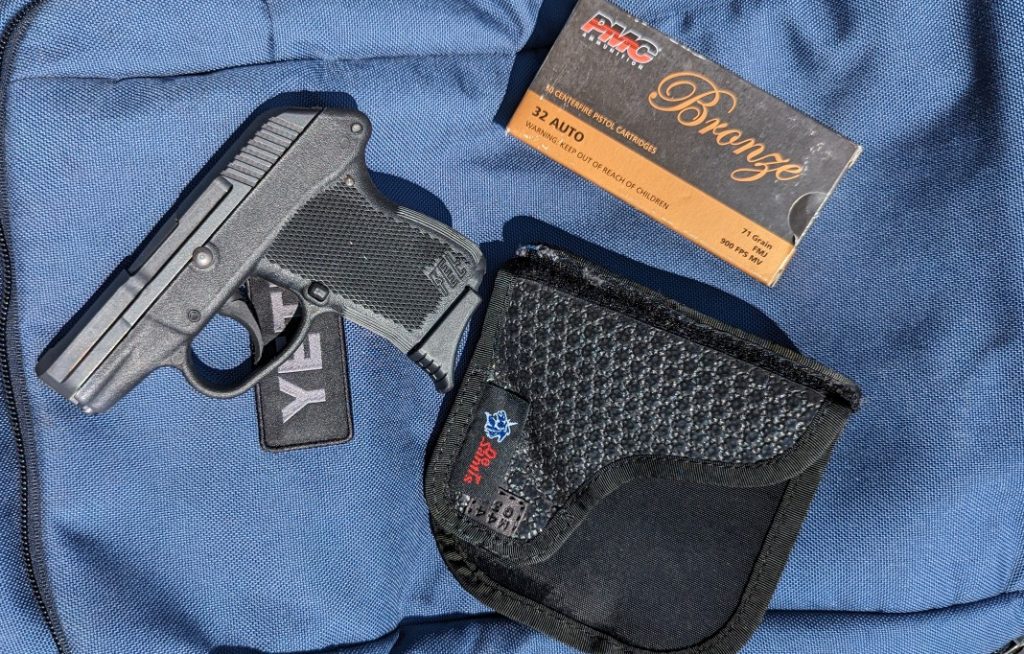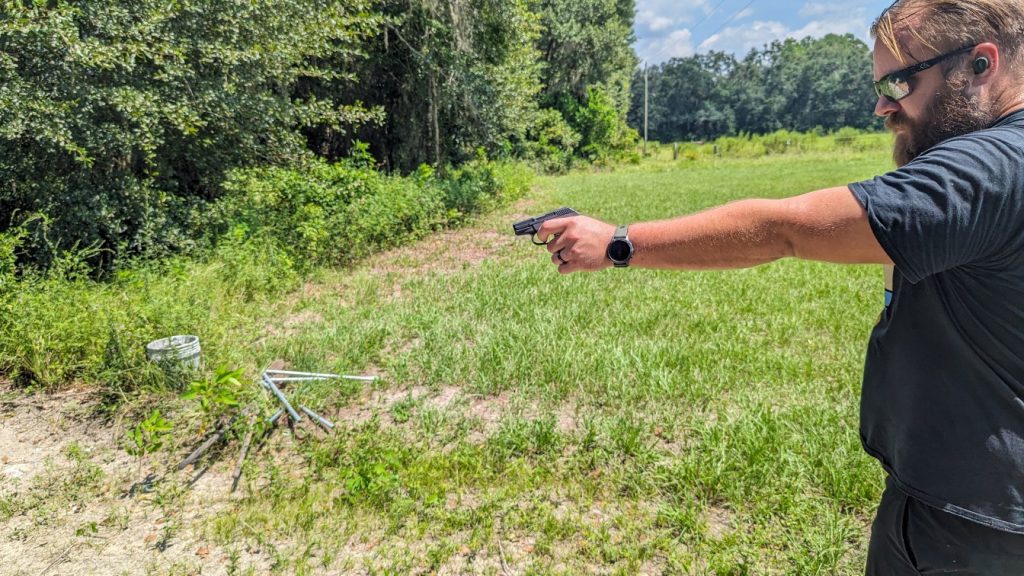Today we are shooting the Mississippi Department of Public Safety Off Duty/Backup firearms qualification course. That’s a fairly long name, so let’s call it the Mississippi Off-Duty gun qual.
I really like backup gun quals. They are typically more applicable to concealed carry since they utilize smaller guns, which are often carried concealed. Backup guns and off-duty guns are not on a duty holster but are often hidden and easy to reach in case of emergency. Backup gun quals allow us to break out the P365, the J-frames, and the pocket pistols.
Going Off Duty
To shoot the Mississippi Off Duty gun qual, you’ll need a small handgun. The qual basically makes it easy to use any small gun outside of a derringer. You can use a snub nose revolver, a modern micro-compact, a Ruger LCP, or whatever else. As long as it can hold five rounds at a minimum, you’re good to go! I’m going to use my KelTec P32 for a real challenge.
Since we are talking ammunition, the Mississippi Off Duty qual only requires 25 rounds. Nothing here to break the bank. You’ll only need one mag, and no speed loaders or speed strips are required for revolvers. It keeps things simple, but you will need a holster. I plan to use the Desantis Superfly I carry my P32 in daily anyway.

Target-wise, the Mississippi DPS provides five options for the various departments that use this qual. We can use the B-27, the TQ-19, the TQ-21, the DOE-15, or the FBI Q target. I like having options and not needing a super specific target. You only need one target, and it would be good to bring something to paste up the targets.
Let’s not forget a shot timer, as well as all the proper eye and ear protection to kick things off! The Mississippi Off-Duty gun qual is a fairly quick shoot, so let’s pop off.
Scoring
Scoring depends on your target. Regardless of the target, there are three ratings to achieve.
- 75% to 85% = Marksman (minimum passing)
- 86% to 92% = Sharpshooter
- 93% to 100% = Expert
Here are the scoring variants, depending on your target:
Target B-27 (All Versions). Hits inside the 8 ring count as five points, hits inside the 7 ring count as four points, hits outside the 7 ring, and in black count as three points. Multiply the total number of points by .4 to score.
Target TQ-19 (All Versions). Hits inside the center of mass and the head area count as two points. Hits in other areas of the silhouette count as one point.
Target TQ-21 (All Versions). Hits inside the center mass and the head area count as two points. Hits in other areas of the silhouette count as one point.
Target DOE-15. Hits inside the center of mass and the head circle count five points, hits inside of the larger center of mass area count four points, and hits in other areas of the silhouette count as three points. Multiply the total number of points by .4 to score.
Target Q (All Versions). Two points will be scored for each hit inside of the bowling pin area.
Blasting Through the Mississippi Off-Duty Qual
A few of the different stages have multiple phases, so make sure you aren’t skipping anything. You’ll need to ensure five rounds are loaded in your weapon before you start blasting away. Get your little gun ready, and let’s light it off!
Stage One: Three-Yard Line
Phase One: Let’s start off nice and close. Since most concealed carry encounters typically start up close, it makes sense. Start with your firearm concealed and in the holster. At the beep, draw and fire two rounds using only your dominant hand. You have three seconds to do so.

Phase Two: Reholster your firearm, but don’t reload. At the beep, we’ll draw and fire three rounds with your weapon hand only. You have four seconds to get those rounds where they are supposed to be.
Stage Two: Three-Yard Line
Phase One: This is a disabled hand drill. Even so, you’ll start with your weapon concealed and in its holster. Prior to hitting the shot timer, draw your weapon with your dominant hand and then transfer the weapon to your non-dominant hand. Now hit the shot timer. When you hear the beep, you’ll fire all five rounds in five seconds.

Stage Three: Five-Yard Line
Phase One: Start with your gun holstered. At the beep, you’ll draw and fire five rounds into the target. You’ll have six seconds to make it happen.

Stage Four: Seven-Yard Line
Phase One: With most handguns, this is nothing, but man, it seems a little further when you’re carrying a pocket pistol with terrible sights. The P32 sights are useable but not highly effective. At this range, you’ll start with the weapon concealed and in the holster. On the command to fire, you’ll draw and fire three rounds in five seconds.

Phase Two: Reholster from Phase One. Now at the beep, draw and fire two rounds, standing, in four seconds.
Stage Five: 10 Yards
Ooh, now we’ve moved to the 10-yard line. Are you nervous? Don’t be. We got this.
Phase One: With the weapon concealed in your holster, draw and fire two rounds standing in five seconds.
Phase Two: With your weapon concealed and holstered, wait for the beep, then draw and fire three rounds standing in six seconds.
My Thoughts
The difficulty of this course of fire will likely vary quite a bit, depending on the gun you’re using. I imagine someone armed with a P365 and a competent holster will fly through this course without much difficulty. If we shrink the gun a bit, we’ll start to see a little more challenge.
Overall I think it’s a great course to shoot through with a deep concealment gun. This means a pocket or ankle gun that can be tough to access. With a standard waist holster, it won’t be much of an issue. This can be a fun skills test for those guns that have small grips, bad sights, and often long trigger pulls. Try it with an LCP, a P32, or a J-frame revolver. It can push your limits, especially if you demand strict accuracy.
Hitting a man-sized target is easy, but replace that man-sized target with a B-8 and only accept the black shots, and you’ll be speaking an entirely new language. Ultimately I think this is a great pocket pistol course of fire and perfect for training your draw and engagements from the pocket.
Shoot, score it, and let us know what you think below.

